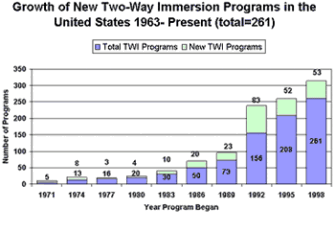In his first comprehensive address on Hispanic education during his seven years in office, Secretary of Education Richard W. Riley last week promoted a bilingual teaching strategy intended to help students learn two languages at the same time.

|
| Secretary of Education Richard W. Riley calls for more “dual immersion” and early-intervention programs last week during his first comprehensive speech on the state of Hispanic education. —Benjamin Tice Smith |
So-called dual-immersion programs, in which native English-speaking and non- English-speaking students learn together in the same class, are an idea whose time has come in a global economy, Mr. Riley said.
Mr. Riley also called on schools and communities to work to close the achievement gap between Hispanic students and their peers by using early-intervention strategies and better teacher training. He used the address, titled “Excelencia Para Todos—Excellence for All: The State of Hispanic Education and Challenges of a New Century,” to point out what he believes are best practices and research to help guide schools that are struggling to educate a growing population of Hispanic students.
For More Information |
| Read the text of Mr. Riley’s speech, from the U.S. Department of Education. |
Not only are Hispanics the nation’s fastest-growing minority group— it is projected that they will be the largest U.S. minority in five years—they are also likely to be the least educated, according to the Department of Education.
Although the event, held at a public school here, attracted little attention on Capitol Hill, Hispanic and bilingual education advocates were happy to hear Mr. Riley’s speech.

|
| SOURCE: Courtesy Center for Applied Linguistics. |
“It was wonderful the secretary of education recognized the need to pay attention to the education of Hispanic children,” said Delia Pompa, the executive director of the National Association of Bilingual Education, who previously served as the Education Department’s top bilingual education official.
Mr. Riley defended bilingual education and English-as-a-second-language programs and urged all educators to recognize the value of “bi-literacy.”
“Language is at the core of the Latino experience in this country, and it must be at the center of future opportunities,” he said. “It is high time we begin to treat language skills as the asset they are.”
About 260 dual-immersion programs are in place in U.S. schools now, a number Mr. Riley said he would like to see expand to 1,000 or more in coming years.
Ms. Pompa described such programs as the “wave of the future” in bilingual education and argued that they can help all children learn two languages. “It does away with the ‘us against them’ mentality,” she said.
But the Center for Equal Opportunity, a Washington-based research group that has been critical of bilingual education, criticized Mr. Riley’s endorsement of that approach. Too often, according to the group, most of the instruction is given in Spanish, and the focus on learning English is inadequate.
“These programs are great for native English-speakers who wish to learn a second language, but they do a disservice to language-minority children who so desperately need to learn English as quickly as possible,” Linda Chavez, the group’s president, said in a written statement.
Equal Time
Oyster Elementary School in Washington has been using dual-immersion programs with success since 1971, said Principal Paquita Holland. Parents and community leaders “wanted an education program that wouldn’t be divisive and [would] build on the strengths of living in integrated neighborhoods,” she said.
Now, all 325 students take part in such programs, and even students who come to the school with no English skills become bilingual and bi-literate within three or four years, she said. Each class has two teachers, one teaching in English, the other in Spanish. Each language receives equal weight—a key to the program’s success, Ms. Holland said.
In his speech, Mr. Riley also called for a $50 million-a-year appropriation to recruit and train bilingual teachers. There are about 50,000 bilingual education vacancies across the country—21,000 in California alone, according to Ms. Pompa’s organization.
The secretary chose Bell Multicultural High School, a 700-student public school in a racially diverse neighborhood here, as the site of his address. Although 95 percent of the school’s students live below the poverty line, the school has a 95 percent attendance rate, and 70 percent of the students go on to college.
Mr. Riley attributed the school’s success to parental and community involvement, high- quality programs and teachers, and after-school programs—strategies other schools should take note of, he said.
